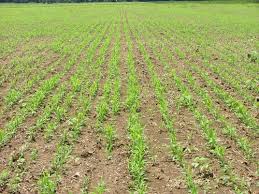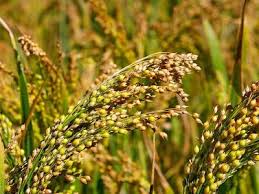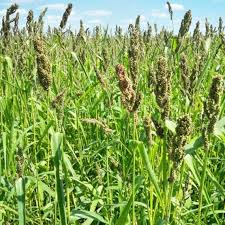Millet Grass, scientifically known as Panicum miliaceum, is a type of plant that grows in many parts of the world. This grass is important because it provides food for people and animals. Millet Grass is special because it can grow in places where other crops might not do so well.
Millet Grass has a strong stem and long leaves. It can grow quite tall, sometimes reaching up to four feet. The leaves of Millet Grass are usually green, and they help the plant make its own food through a process called photosynthesis. This process uses sunlight to turn water and carbon dioxide into energy, which the plant needs to grow.
One of the interesting things about Millet Grass is that it produces seeds. These seeds are small and round, and they can be used to make different types of food. People have been eating millet seeds for a very long time. They can be cooked and eaten just like rice, or they can be ground into flour to make bread and other foods.
Farmers also like to grow Millet Grass because it is a tough plant. It can survive in places where the soil is not very good and where there might not be a lot of water. This makes it an important crop in areas where other plants might not be able to grow well.
Millet Grass is not only good for people, but it’s also good for animals. Farmers often use Millet Grass as animal feed. Animals like cows, sheep, and chickens can eat the leaves and seeds of the plant, which provides them with the nutrients they need to stay healthy.
In some parts of the world, Millet Grass is also used to help control soil erosion. The roots of the plant help hold the soil together, preventing it from being washed away by rain and wind. This is important for keeping the land fertile and preventing desertification.
In addition, Millet Grass is a valuable plant that has been helping people and animals for a very long time. Its ability to grow in tough conditions, provide nutritious seeds, and help with soil erosion makes it an important part of agriculture and the environment. So, the next time you see Millet Grass, remember its significance in our lives.
Read Also: 10 Medicinal Health Benefits of Atractylodes lancea (White Atractylodes)
How to Grow and Care for Millet Grass

Growing and caring for Millet Grass is relatively simple and rewarding. Here’s a step-by-step guide to help you:
1. Choose the Right Location: Millet Grass thrives in full sun, so select a location that receives at least 6 to 8 hours of sunlight each day. It can tolerate a variety of soil types, but well-draining soil is ideal.
2. Prepare the Soil: If the soil is heavy or clayey, add compost or well-rotted manure to improve drainage and fertility. Mix it into the top few inches of soil before planting.
3. Planting: Plant Millet Grass seeds directly in the soil after the last frost date in your area. Plant the seeds about 1/4 to 1/2 inch deep and space them about 1 to 2 inches apart. You can plant them in rows or broadcast them for a more natural look.
4. Watering: Keep the soil consistently moist but not waterlogged during the germination period. Once the plants are established, they are relatively drought-tolerant, but it’s still important to provide water during dry spells.
5. Thinning: When the Millet Grass seedlings are about 3 to 4 inches tall, thin them out to leave about 6 to 12 inches of space between plants. This gives them room to grow and minimizes competition for nutrients.
6. Fertilizing: Millet Grass doesn’t usually require a lot of fertilization. A balanced, all-purpose fertilizer can be applied sparingly at the beginning of the growing season.
7. Pest and Disease Control: Millet Grass is generally resistant to pests and diseases, but it’s always a good idea to keep an eye out for any signs of trouble. If you notice any issues, consult with a local gardening center for appropriate treatments.
8. Harvesting: Millet Grass is typically ready to harvest when the seeds have turned a golden color and are hard to the touch. Cut the seed heads and hang them upside down in a dry, well-ventilated area to further dry the seeds.
9. Seed Saving: If you want to save seeds for future planting, thresh the dried seed heads to remove the seeds. Store the seeds in a cool, dry place in airtight containers.
10. Overwintering: In colder climates, Millet Grass is an annual plant and won’t survive the winter. You can till the plants into the soil after harvest to enrich it with organic matter.
Remember that each variety of Millet Grass might have slightly different growing requirements, so it’s a good idea to check the specific instructions on the seed packet or with your local gardening center. With proper care and attention, you can enjoy the beauty and benefits of Millet Grass in your garden.
Benefits and Uses of Millet Grass

Millet Grass offers a range of benefits and versatile uses, making it a valuable plant in various aspects of human life and agriculture:
1. Nutritious Food Source: Millet Grass produces seeds that are rich in essential nutrients such as carbohydrates, proteins, dietary fiber, and vitamins. These seeds are gluten-free and have a low glycemic index, making them suitable for people with dietary restrictions or diabetes.
2. Human Consumption: Millet seeds can be cooked and eaten as a whole grain, similar to rice or quinoa. They can also be ground into flour to make baked goods like bread, muffins, and pancakes. Millet-based foods are gaining popularity due to their nutritional value and potential health benefits.
3. Animal Feed: Millet Grass is an important fodder crop for livestock. The leaves and seeds provide valuable nutrients to animals like cows, sheep, and poultry, contributing to their growth and overall health.
4. Soil Improvement: The extensive root system of Millet Grass helps prevent soil erosion by stabilizing the soil structure. This is particularly beneficial in areas prone to erosion or in regions with poor soil quality.
5. Crop Rotation: Millet Grass can be used as a rotational crop to break pest and disease cycles in agricultural fields. It can help reduce the buildup of specific pests or pathogens that target other crops.
6. Cover Crop: Millet Grass can serve as a cover crop during fallow periods. Cover crops protect the soil from erosion, suppress weed growth, and improve soil fertility by adding organic matter when tilled back into the soil.
7. Biodiversity: Millet Grass contributes to biodiversity by providing habitat and food sources for various insects and small animals. This can help maintain a balanced ecosystem in agricultural and natural areas.
8. Sustainable Agriculture: Millet Grass is well-suited for sustainable farming practices due to its ability to grow in diverse climates and soil conditions. Its low water and fertilizer requirements make it an environmentally friendly option.
9. Culinary Diversity: Different types of millet offer culinary diversity, with unique flavors and textures. From finger millet to pearl millet, various millet varieties are used in traditional dishes across cultures.
10. Traditional Medicine: In some cultures, Millet Grass is used for its potential health benefits. It’s believed to have properties that aid digestion, regulate blood sugar levels, and provide energy.
11. Craft and Art: Millet stalks can be used in crafts such as basket weaving and thatching. In some cultures, these stalks are used to create traditional art and handicrafts.
Overall, Millet Grass is a versatile plant that contributes to food security, sustainable agriculture, and environmental preservation. Its benefits and uses span from human nutrition to ecological conservation, showcasing its importance in various aspects of our lives.
Read Also: 10 Medicinal Health Benefits of Atractylodes (tractylodes macrocephala)
Where to Find Millet Grass near Me/You

Millet grass and its seeds can be found in various places, depending on your purpose, whether it’s for gardening, culinary use, or animal feed. Here are some places where you can find or locate Millet Grass and its seeds:
1. Garden Centers and Nurseries: Many garden centers and nurseries sell Millet Grass seeds and young plants, especially during the planting season. Look for native or ornamental varieties that suit your gardening needs.
2. Seed Catalogs: Seed catalogs, both online and print versions, offer a wide variety of Millet Grass seeds. These catalogs often provide detailed information about each type of millet, including growth habits and recommended uses.
3. Online Retailers: Numerous online retailers specialize in selling seeds for various plants, including Millet Grass. You can find a wide range of options, compare prices, and read reviews to make an informed choice.
4. Local Farmers: If you’re looking for bulk quantities of Millet Grass for animal feed or cover cropping, consider reaching out to local farmers or agricultural supply stores. They might be able to provide you with seeds or direct you to a reliable source.
5. Agricultural Supply Stores: Stores that cater to farmers and gardeners often carry seeds for various crops, including Millet Grass. Check with your local agricultural supply store to see if they have Millet Grass seeds available.
6. Specialty Food Stores: If you’re interested in trying different types of millet for culinary purposes, you might find millet-based products like flour, cereal, or snacks in specialty food stores or health food markets.
7. Online Marketplaces: Online marketplaces like Amazon, eBay, and specialized agricultural websites can be convenient sources for purchasing Millet Grass seeds and related products.
8. Local Seed Exchanges: Some communities have seed exchange events or groups where gardeners share and trade seeds. Participating in such events might allow you to obtain Millet Grass seeds.
9. Farms and Agricultural Research Institutions: Some farms and agricultural research institutions may offer Millet Grass seeds or plants as part of their research projects or outreach programs.
When looking for Millet Grass, make sure to consider the specific variety that suits your needs, whether it’s for ornamental landscaping, gardening, animal feed, or culinary use. Additionally, ensure that you’re sourcing seeds from reputable suppliers to ensure the quality and authenticity of the product.
Read Also: Key Strategies In Becoming Successful In International Marketing
